by Patricia A. Kaufmann
Due to the revolutionary nature of the material presented, this article appeared in both the American Philatelist and the Confederate Philatelist at the same time in February 2000 by joint cooperation of the editorial teams. The research resulted in the addition of a completely new section in the Scott Catalogues. If you don't have Broadband Internet connection, this may take a while to download as it is graphic intensive, but ultimately worth the wait.
Sixteen years ago, I wrote a feature article, published in The American Philatelist, 1 suggesting there was a third and different type of postmaster provisional, partly U.S. and partly Confederate that had never been addressed by the appropriate philatelic catalogs such as Scott 2 or Dietz 3. These are the 3-cent provisionals issued by postmasters in states declaring allegiance to the Confederacy before the Confederate postal rates went into effect on June 1, 1861.
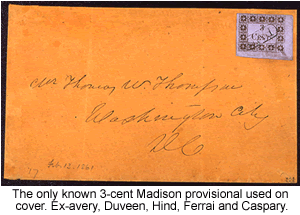 The Confederate States of America was formed on February 4, 1861. On February 9, 1861, the Confederate Provisional Congress at Montgomery, Alabama, adopted an act to continue in force laws of the United States of America until the Confederate Congress could change such laws. By default, this established the postal rates of the Confederate States as being the same as those of the United States. 4. The act prescribing the rates of postage in the Confederate States of America was passed and received presidential approval and signature on February 23, 1861, but did not go into effect until June 1, 1861.
The Confederate States of America was formed on February 4, 1861. On February 9, 1861, the Confederate Provisional Congress at Montgomery, Alabama, adopted an act to continue in force laws of the United States of America until the Confederate Congress could change such laws. By default, this established the postal rates of the Confederate States as being the same as those of the United States. 4. The act prescribing the rates of postage in the Confederate States of America was passed and received presidential approval and signature on February 23, 1861, but did not go into effect until June 1, 1861.
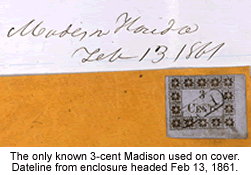 Postmasters from the seceded states that joined the Confederacy found themselves in a very difficult position. While most postmasters were sympathetic to the South and intended subsequently to accept Confederate postmaster commissions, they were still technically under oath to the United States Post Office Departmentuntil June 1, 1861. The United States demanded a confirming oath from these Southern postmasters before shipping additional supplies of U.S. stamps to them during the period between the formation of the Confederacy and June 1, 1861. 5 Confederate Postmaster General John H. Reagan advised Southern postmasters that, in the interests of the people in both parts of the country, it was the wish of the Confederate government that all postmasters continue their duties, render their accounts, and pay all monies to the government of the United States until the Confederate Post Office Department could assume control over its own postal affairs. 6 In a letter written by Reagan in 1898 in reply to some inquiries concerning Confederate postal matters, he explained the Confederate Post Office Department's official position relative to postmasters provisional stamps. 7
Postmasters from the seceded states that joined the Confederacy found themselves in a very difficult position. While most postmasters were sympathetic to the South and intended subsequently to accept Confederate postmaster commissions, they were still technically under oath to the United States Post Office Departmentuntil June 1, 1861. The United States demanded a confirming oath from these Southern postmasters before shipping additional supplies of U.S. stamps to them during the period between the formation of the Confederacy and June 1, 1861. 5 Confederate Postmaster General John H. Reagan advised Southern postmasters that, in the interests of the people in both parts of the country, it was the wish of the Confederate government that all postmasters continue their duties, render their accounts, and pay all monies to the government of the United States until the Confederate Post Office Department could assume control over its own postal affairs. 6 In a letter written by Reagan in 1898 in reply to some inquiries concerning Confederate postal matters, he explained the Confederate Post Office Department's official position relative to postmasters provisional stamps. 7
I stated in the report referred to that it was necessary "to leave it to postmasters and person paying postage to arrange between themselves the manner in which these notes may be used." Under this condition occurred the issuance of local stamps and stamped envelopes by quite a number of Confederate postmasters.
The preceding information is merely a condensation of the vast basis for my proposal that there should be a third category of provisionals. In the original article, I gave the history of the 3-cent issues from Madison, Florida; Jackson, Mississippi; Hillsboro, North Carolina; Tuscumbia, Alabama; and Nashville, Tennessee. On the whole, this article was extraordinarily well accepted by the philatelic community. I subsequently received many letters and accolades as well as information on other contenders for this new classification. All of sudden, I become the clearing house for anything of an ambiguous nature and more listings have since been added to this post-secession provisional category.
Michael Laurence, editor of Linn's Stamp News, wrote three different editorials quoting my research, adding his own thoughts an swelling my head with praises such as "Kaufmann's article is one of the most impressive pieces of philatelic research we've ever encountered." 8-10
Shock and Deflation
Imagine my shock and devastation when, after confidently having sent off several of the Madison, Florida 3-cent provisionals written up in the article, they came back from the Philatelic Foundation in March of 1995 with "decline opinion" instead of good certificates. How could this be?
J. W. Scott, the found of the Scott Catalogue himself, had discovered the first of the Madison provisionals (the "CNETS" error) and stated in 1872 that "the Madison was the first issued, best authenticated, and scarcest Confederate provisional". 11 It was listed in the Scott Catalogue at that time at least through 1896 and probably for decades thereafter. 12 Another of the rare provisionals (the only known Confederate rated 5-cent press printed entire) was discovered in 1895 by C. H. Mekeel, founder of Mekeel's
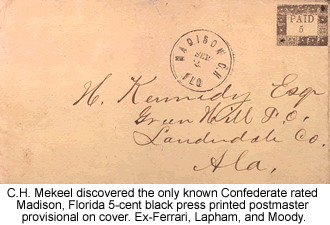 Weekly Stamp News. 13, 14 The Madison provisionals had passed through the greatest of collections of the late nineteenth and early twentieth centuries including Caspary, Ferrari, Hind, Duveen, Moody, Lapham, Judge Philbrick and Sir William Avery. I had spent days at the National Archives on my original research, pored over vast numbers of philatelic volumes and corresponded with endless experts - all seemingly for naught.
Weekly Stamp News. 13, 14 The Madison provisionals had passed through the greatest of collections of the late nineteenth and early twentieth centuries including Caspary, Ferrari, Hind, Duveen, Moody, Lapham, Judge Philbrick and Sir William Avery. I had spent days at the National Archives on my original research, pored over vast numbers of philatelic volumes and corresponded with endless experts - all seemingly for naught.
A chat over lunch with one of the Philatelic Foundation staff revealed that no one knew exactly why the Madisons had been de-listed from the various catalogues years before. A reply from Scott Publishing revealed that "Any files of J. W. Scott before 1880 were burned in a fire. Also, any files dated up to 1950 are not available as they are the property of private owners." 15 No answers were forthcoming from the Scott archives. Another concern expressed by the Foundation was that they did not have records of any other examples of the canceling devices used on the Madisons, either the oblong "PAID" or the rare small Madison "FLO" circular datestamp. Furthermore, the name of Dr. James A. Petrie was associated with the Madisons. Petrie was known to have openly boasted of having sold Ferrari many of the fakes and counterfeits in his remarkable collection.16
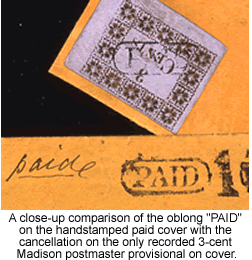 All of these were genuine concerns, but I was still quite secure with my prior research and conclusions. The only suggestion, which seemed totally irrational to me, was that the original papers I had found in the National Archives written by Madison postmaster Samuel J. Perry might somehow have been "planted" by Petrie to help authenticate the provisionals. These letters were published in my original article. This suspicion seemed unlikely to be true, as the reply from Perry to the U.S. Post Office Department would not have been specifically referenced in the Baltimore American and Commercial Advertiser on March 21, 1861 had it been a "plant".
All of these were genuine concerns, but I was still quite secure with my prior research and conclusions. The only suggestion, which seemed totally irrational to me, was that the original papers I had found in the National Archives written by Madison postmaster Samuel J. Perry might somehow have been "planted" by Petrie to help authenticate the provisionals. These letters were published in my original article. This suspicion seemed unlikely to be true, as the reply from Perry to the U.S. Post Office Department would not have been specifically referenced in the Baltimore American and Commercial Advertiser on March 21, 1861 had it been a "plant".
The Foundation did not condemn the Madisons. They merely required more proof. As with any Authentication Committee, it is up to the submitter to do the research and present it to the committee. It is not the job of the committee to do the research, or certificates would cost thousands of dollars each and "patients" would take years to process. I momentarily was dejected, but now, with my work cut out for me, I put myself in the mind set for positive action.
The Quest Begins Anew: Cancel Corroboration
F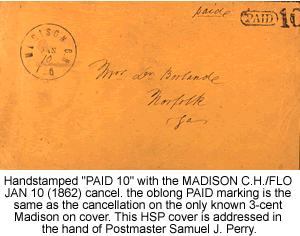 irst things first. I needed to corroborate the cancellations that were used on the known Madison provisionals. In November 1984, I wrote to those who might be able to provide supporting evidence, from Florida collectors and dealers to handstamped paid experts. I was deluged with a truckload of helpful information and acquired many corroborating Madison covers along the way. Among other things, it was erroneously suggested by some that cancellations with other than "FLA" weren't used in Florida during the Civil War. It didn't take me long to come up with small "FLO" postmarks from Pensacola, Saint Augustine, and, thankfully, Madison. The late eminent handstamped paid student, Morris Everett, sent me a survey of all the Madison handstamped paids of which he was aware, their sources, and when they had been sold. 18 Among them were two Type II Madison oblong PAID's from the Borland correspondence. They appear to have been the covers from which the Type II was listed. 19 Publisher/dealer David Phillips checked his files on both the American Stampless Cover Catalog and Confederate Stampless Cover Catalog and supplied me with photocopies of Madison postmarks before, during and after the Civil War.20
irst things first. I needed to corroborate the cancellations that were used on the known Madison provisionals. In November 1984, I wrote to those who might be able to provide supporting evidence, from Florida collectors and dealers to handstamped paid experts. I was deluged with a truckload of helpful information and acquired many corroborating Madison covers along the way. Among other things, it was erroneously suggested by some that cancellations with other than "FLA" weren't used in Florida during the Civil War. It didn't take me long to come up with small "FLO" postmarks from Pensacola, Saint Augustine, and, thankfully, Madison. The late eminent handstamped paid student, Morris Everett, sent me a survey of all the Madison handstamped paids of which he was aware, their sources, and when they had been sold. 18 Among them were two Type II Madison oblong PAID's from the Borland correspondence. They appear to have been the covers from which the Type II was listed. 19 Publisher/dealer David Phillips checked his files on both the American Stampless Cover Catalog and Confederate Stampless Cover Catalog and supplied me with photocopies of Madison postmarks before, during and after the Civil War.20
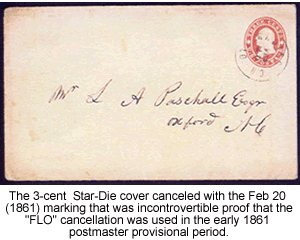 On November 29, 1984, the late Bill Bogg, a prominent Confederate dealer, Florida collector, and good friend, pointed me to the clinching cover, which he said came from the Henry Spelman collection. It was a 3-cent Star-Die envelope canceled with the "Feb 20 (1861) Madison, FLO" marking that became incontrovertible proof that the "FLO" cancellation was used during the provisional period. The U.S. 3-cent Star-die envelopes were not issued until after February 1860 and were not valid in the Confederacy in 1862, thus narrowing down the usage to 1861. This is a well-accepted proof of dating among Confederate postal history students.
On November 29, 1984, the late Bill Bogg, a prominent Confederate dealer, Florida collector, and good friend, pointed me to the clinching cover, which he said came from the Henry Spelman collection. It was a 3-cent Star-Die envelope canceled with the "Feb 20 (1861) Madison, FLO" marking that became incontrovertible proof that the "FLO" cancellation was used during the provisional period. The U.S. 3-cent Star-die envelopes were not issued until after February 1860 and were not valid in the Confederacy in 1862, thus narrowing down the usage to 1861. This is a well-accepted proof of dating among Confederate postal history students.
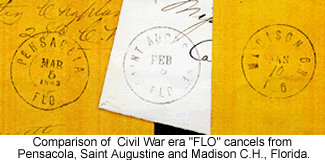 The Star-Die cover, as well as the others that I had accumulated in my all-out efforts, clearly produced a time line theory, illustrated herein with the actual markings on cover. The small Madison "FLO" postmark appears to have been used during 1861 through early 1862, as does the oblong PAID.
The Star-Die cover, as well as the others that I had accumulated in my all-out efforts, clearly produced a time line theory, illustrated herein with the actual markings on cover. The small Madison "FLO" postmark appears to have been used during 1861 through early 1862, as does the oblong PAID. 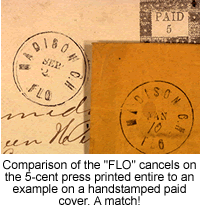 The large Madison, FLO was used in early 1862. It appears that these two canceling devices were discarded, probably because of wear or breakage, and there followed an interim period where only manuscript cancellations are found during 1862 and 1863. Finally, the larger and most common "FLA" cancellation is found during 1863 and 1864.
The large Madison, FLO was used in early 1862. It appears that these two canceling devices were discarded, probably because of wear or breakage, and there followed an interim period where only manuscript cancellations are found during 1862 and 1863. Finally, the larger and most common "FLA" cancellation is found during 1863 and 1864.
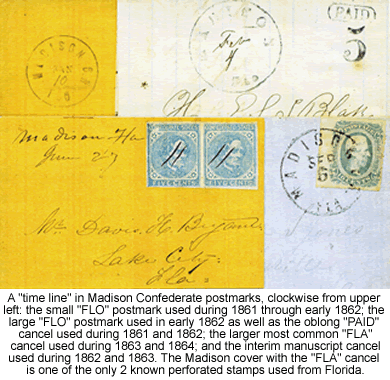
From Confederate Newspapers to Postmaster Descendants
April 8, 1985, was a red-letter day in my Madison research. It began at the Library of Congress and ended in a long phone conversation with the great-great grandson of Confederate Postmaster Samuel J. Perry.
The first phone call I made that day was to the newspaper section in the Library of Congress. They did not have a copy of the Madison Recorder, the newspaper of the day in Madison, Florida where I thought the stamps were printed. I noted with amusement that the reading room of the Library of Congress is LM-133 in the Madison Building - a nice coincidence. That seemed a good omen. One of the staff there told me that a copy of this rare paper was on file at Florida State University in Tallahassee and University of Florida in Gainesville, I also called Florida telephone information in hopes of finding descendants, but there was no one by the name of Perry listed in Madison in 1985.
According to the records in the Florida State Library in Tallahassee, The Madison Recorder was published from 1865 until June 1908. I later was renamed The New Enterprise and subsequently The Enterprise-Recorder, under which name it is published today. In a phone call to the office of the paper, I asked if there was any type of historical society in Madison and was put in touch with Beth Sims who was writing a book on Madison County history. I asked her if she had ever heard of a postage stamps from Madison and she said that she had. Furthermore, she indicated that a friend had sent her a copy of The American Philatelist that had a story in it about the Madison provisionals. I told her that I was the author of that article. Mr. Sims then went on to tell me that William Perry, who was Postmaster Samuel J. Perry's son, had printed the Civil War era newspaper in Madison, but that she did not think there were any copies extant. She also noted that a descendant of Perry's was being buried as we spoke.
Mrs. Sims gave me one of the most important leads in my new quest - the name of James H. Perry of Palatka, Florida. She indicated that he and his wife were doing genealogical research on Samuel Perry. I was getting closer. I made several phone calls, but to no avail.
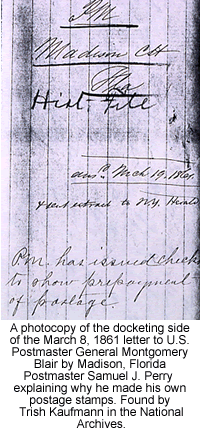 In the meantime, I continued with my library research. Mrs. Sims called me back in the afternoon to say that the paper that I really wanted was The Southern Messenger. I already had uncovered this same information at the P. K. Younge Library, which had an issue from December 25, 1858, as well as two issues from April 20 and April 27, 1866. I ordered photocopies of the entire paper via the Inter-Library Loan Program to find the fancy type from which the border of the provisional stamps was made. I found that the typeface of the "3-cents" matched that of the paper, but I never did find the border.
In the meantime, I continued with my library research. Mrs. Sims called me back in the afternoon to say that the paper that I really wanted was The Southern Messenger. I already had uncovered this same information at the P. K. Younge Library, which had an issue from December 25, 1858, as well as two issues from April 20 and April 27, 1866. I ordered photocopies of the entire paper via the Inter-Library Loan Program to find the fancy type from which the border of the provisional stamps was made. I found that the typeface of the "3-cents" matched that of the paper, but I never did find the border.
That evening, I finally got through by telephone to James H. Perry, who is known as "Buddy". He was excited to hear from me and surprised to find out that his great-great-grandfather, Samuel James Bradley Perry, had been postmaster during the Civil War. He said that he knew very little about this particular period of his family, but hat he had been doing a great deal of genealogical research. He always referred to Samuel J. Perry as "Colonel Sam" because he was a judge and that is how they referred the judges in those days. It turns out that Colonel Sam's son, William was not only the editor of The Southern Messenger in Madison, but also of newspapers in Americus, Georgia, about 1870 and in Jacksonville, Florida in the early 1870's. Buddy indicated that he had Colonel Sam's signature on land deeds, probate items, and his last will and testament, as well as on other documents. This was to play a crucial part in another phase of my research, the verification of Colonel Sam's handwriting by a professional graphologist.
Buddy Perry and his wife, Mary Jo, invited my late husband, John, and me to dinner at their home in Palatka during our research trip to Florida a few weeks later. We had a wonderful time and the mutual exchange of information was very productive for all of us. Mary Jo was the conference chairman for the Florida State Genealogical Society, and thus had a wealth of knowledge on Florida pioneers. The Perrys most generously provided me with copies of many original family documents such as voting records, Colonel Sam's obituary, the 1870 census in which his family appeared, letters written by him asking for the right to survey roads in Madison, field notes made during his surveys, his Indian War pension papers, and copies of church records when he was a clerk of the session.
Samuel James Bradley Perry
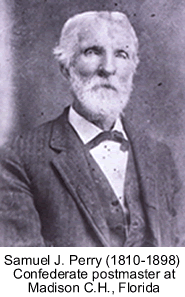 Samuel J. Perry was born near Sumter, South Carolina on August 25, 1810, 21-23 the middle of three children of Senator John Perry of South Carolina. 24 He married Margaret P. McIlveen on December 25, 1828, in Kingstree, South Carolina, and his first two children were born in South Carolina. He moved to Madison County, Territory of Florida, in 1832 or 1833, following his sisters, Mrs. Pillans. His next three children were born in Madison. Perry died on December 11, 1898, while working on his stock farm near Madison, having outlived four of his five children. He is buried in Oakland Cemetery near Madison.
Samuel J. Perry was born near Sumter, South Carolina on August 25, 1810, 21-23 the middle of three children of Senator John Perry of South Carolina. 24 He married Margaret P. McIlveen on December 25, 1828, in Kingstree, South Carolina, and his first two children were born in South Carolina. He moved to Madison County, Territory of Florida, in 1832 or 1833, following his sisters, Mrs. Pillans. His next three children were born in Madison. Perry died on December 11, 1898, while working on his stock farm near Madison, having outlived four of his five children. He is buried in Oakland Cemetery near Madison.
Perry enlisted at San Pedro, Florida as a private in the company of mounted volunteers commanded by Captain Thomas Livingston during the Seminole Indian War. He later served twelve months under a commander named Bradley and was discharged in 1837. His civic commitments over the years were many. He served as judge of the county court of Madison from 1834 to 1839. He was appointed and served as county tax collector from 1839 to 1845. He was the precinct election clerk for Madison County in Florida's first election after statehood and his name appears on the voters roll in Madison County in 1845. Perry was deputy surveyor for the state survey conducted in 1853 and 1854 with U.S. Surveyor General John Westcott. They surveyed thousands of acres of land in South Florida as far as the shores of Lake Okeechobee, long before the Indians were transported or driven back into the Everglades or that part of the state was settled by the white man. 25 Colonel Sam was one of the three original founders of the Presbyterian church in Madison in 1840. At the age of 75, he still was going strong and was elected superintendent of education in 1885. His five children also enriched the community of Madison. Of particular note to postal historians is his eldest son, William, who printed the Madison provisionals as the editor and publisher of The Southern Messenger. Another son, Captain Thomas A. Perry, was a doctor who fought in the Civil War and was killed during the Battle of Seven Pines. May 31-June 1, 1861 (called the Battle of Fair Oaks by the North, both sides claimed victory in the engagement, but the losses were brutally high: 6,180 Confederate casualties; 5,031 Northern casualties.)
Colonel Sam's obituary in the Jacksonville Florida Times Union 26 stated that "He was one of the few remaining landmarks of the old pioneer settlements. He was a man of fine intellectual attainments, a Christian gentleman and a patriot, honored by all who knew him. His remains were interred at Oakland Cemetery beside that of the wife of his youth, who had long ago preceded him." His first wife died in 1872. His second wife was Susan Rutherford.
Madison Stamps Cause a Scandal in 1861
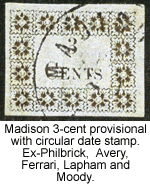 In my original article, I quoted The New York Herald, which early in 1861 had announced: "The PostMaster at Madison Fla has offered P Office Stamps contrary to Law." In the National Archives, I found the original letter that Postmaster Perry wrote to U.S. Postmaster General Montgomery Blair on March 8, 1861, refuting these charges. I published that letter in my article as well. A search of the Blair letter book revealed that he was answered in March 1861, but the letter was not in the records. As a result of the original Herald article, a postal inspector was sent from Washington to interview Perry, who apparently explained himself to the inspector's satisfaction. A March 1861 issue of the Fayetteville, North Carolina Observer indicated, however, that he was severely lectured the third assistant postmaster general. An article in the march 1872 American Journal of Philately published a long detailed letter from former Postmaster Perry to J. W. Scott in response to Scott's inquiry after discovering the "CNETS" error, a small portion of which is quoted here.
In my original article, I quoted The New York Herald, which early in 1861 had announced: "The PostMaster at Madison Fla has offered P Office Stamps contrary to Law." In the National Archives, I found the original letter that Postmaster Perry wrote to U.S. Postmaster General Montgomery Blair on March 8, 1861, refuting these charges. I published that letter in my article as well. A search of the Blair letter book revealed that he was answered in March 1861, but the letter was not in the records. As a result of the original Herald article, a postal inspector was sent from Washington to interview Perry, who apparently explained himself to the inspector's satisfaction. A March 1861 issue of the Fayetteville, North Carolina Observer indicated, however, that he was severely lectured the third assistant postmaster general. An article in the march 1872 American Journal of Philately published a long detailed letter from former Postmaster Perry to J. W. Scott in response to Scott's inquiry after discovering the "CNETS" error, a small portion of which is quoted here.
The keen perceptions of James Gordon Bennett of the New York Herald found an immense and ingenious fraud practiced upon the Government by the postmaster at Madison, and called hastily for justice to visited upon the moral deformity of the offending postmaster at Madison. His exquisite sense of purity could not conceive how a sense of duty on the part of the officers of the distributing office could allow the offense of the postmaster at Madison to go unnoticed. He devoted nearly a column of the Herald to the subject, and I found myself suddenly famous through the Herald's cleverness in discovering villainy. Shortly after the Herald's attention, an agent of the Government was sent especially to investigate the fraud; but he was a sensible gentleman, and was immediately convinced that no wrong was intended and so reported to his Government was continued, without further complaint...when I made the proper returns and paid up all dues in money.
A Visit Back in Time
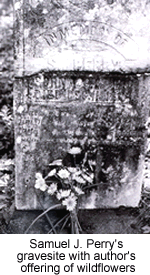 The morning after we had dinner with Buddy and Mary Jo Perry at their home in Palatka, we were finally on our way to Madison, Florida. Our first stop was Oakland Cemetery. At 8:30 a.m., we drove our rental car down the winding red clay and sliding sand road past peaceful farm fields dappled with spring wildflowers. We followed the tractors treads on the dirt road through a tunnel of live oak trees draped in Spanish moss to an unkempt cemetery hidden behind rusty iron and brick gates. Five small Palmetto trees flanked the gates and the cemetery was dotted with more Spanish moss covered trees.
The morning after we had dinner with Buddy and Mary Jo Perry at their home in Palatka, we were finally on our way to Madison, Florida. Our first stop was Oakland Cemetery. At 8:30 a.m., we drove our rental car down the winding red clay and sliding sand road past peaceful farm fields dappled with spring wildflowers. We followed the tractors treads on the dirt road through a tunnel of live oak trees draped in Spanish moss to an unkempt cemetery hidden behind rusty iron and brick gates. Five small Palmetto trees flanked the gates and the cemetery was dotted with more Spanish moss covered trees.
We found the Perry family markers broken in half and darkened with mildew. They were set back away from most of the other gravestones. We took pictures as they were found and then set the top halves on the bottoms to properly reconstruct the ponderous teetering slabs. I gathered a handful of wildflowers to place on he grave and said a small prayer for Colonel Sam and his family. I noted that his headstone inscription erroneously recorded the year of his death as 1899.
Our trip into Madison was just as fascinating as we had anticipated. We visited the gold-domed court house, the post office, the local library, and the office of the current local newspaper, The Madison Enterprise-Recorder. We met with Mrs. Elizabeth Sims of the Madison Historical Society, who subsequently published her book on the history of Madison county, 27 to which she added the stony of Colonel Sam's stamps. I discovered even more reference material - far too voluminous to cover here. One of the more interesting titles that I encountered was Scenes in a Surveyor's Life or a Record of Hardships and Dangers Encountered and Amusing Scenes which Occurred in the Operations of a Party of Surveyors in South Florida by W. L. Perry. 28. This lengthy mouthful of a title was a collection of anecdotes from Colonel Sam's illustrious past as written by his son.
We pored over old newspapers at the offices of The Madison Enterprise-Recorder for hours. I chuckled at the tag line on the paper's masthead "Since 1865 'telling it like it is...and defending the peasants' right to know!'" I subsequently even ran an ad in that publication looking for information on the Madison provisionals - or, better yet, for someone who might still have a 1-cent, 3-cent, or 5-cent stamps he was willing to sell! That philatelic fantasy, of course, remained just that - a fantasy.
One news article from 1919 did catch my eye. It was titled "That Confederate Post Stamp". 29
An old timer of Washington once a resident of this town writes entertainingly of this stamp, he has a retentive memory and his mind is chock full of interesting facts. Tradition claims that during the War of the 60s when Col. S. J. Perry was Postmaster in Madison, the times were strenuous and there were no Post Stamps to be procured, so Col. Perry designed and manufactured this one and put it into circulation. The picture of this stamps is to be seen in many large Philatelic catalogues. There is neither art or skill in its make up, but no doubt on a genuine Confederate envelope it would be a valuable prize to a Philatelist. The late Col. Perry was a most magnetic conversationalist and in talking of the days when he invented a Post Stamp he was eloquent.
Handwriting Analyses
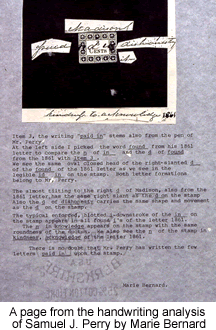 With the acquisition of so many documents with Colonel Sam's handwriting and signatures, my next step was to find a graphologist to compare a half dozen samples of his handwriting. I chose a leading handwriting expert, the internationally respected Marie Barnard, who has written over a dozen books of graphology as well as co-authoring Anatomy of Evil with Charles Hamilton, the esteemed autograph dealers, for whom she wrote over 160 analyses of Nazi leaders. She has taught graphology in New York's City College, the University of Bridgeport, and the John Jay College of Criminology, as well as appearing regularly in court as a questioned document examiner. I sent Ms. Bernard copies of six items: the provisional stamp with the manuscript cancel; the letter on file at the National Archives to the U.S. Postmaster General dated March 8, 1861; the letter from Perry to Dr. Petrie in 1880; and a few covers with manuscript cancels and addresses in Perry's hand that came from an original find made by Joe Holleman. 30 In a multi-page analysis, she returned the opinion that there was no doubt that they were all written by Perry.
With the acquisition of so many documents with Colonel Sam's handwriting and signatures, my next step was to find a graphologist to compare a half dozen samples of his handwriting. I chose a leading handwriting expert, the internationally respected Marie Barnard, who has written over a dozen books of graphology as well as co-authoring Anatomy of Evil with Charles Hamilton, the esteemed autograph dealers, for whom she wrote over 160 analyses of Nazi leaders. She has taught graphology in New York's City College, the University of Bridgeport, and the John Jay College of Criminology, as well as appearing regularly in court as a questioned document examiner. I sent Ms. Bernard copies of six items: the provisional stamp with the manuscript cancel; the letter on file at the National Archives to the U.S. Postmaster General dated March 8, 1861; the letter from Perry to Dr. Petrie in 1880; and a few covers with manuscript cancels and addresses in Perry's hand that came from an original find made by Joe Holleman. 30 In a multi-page analysis, she returned the opinion that there was no doubt that they were all written by Perry.
A Special Meeting of the Philatelic Foundation
Finally, I felt that I had an overwhelming amount of evidence that the experts at the Foundation could not ignore. In May 1987, I sent the a one-inch thick report with 18 pages of footnoted text with 33 separate exhibits such as the handwriting analyses, many of which were several pages long. After almost a year, during which time various experts had the opportunity to examine the research, a special meeting was called in March 1988, which John and I were invited to attend in person.
It was an active evening of open dialogue that ultimately ended with with the Madison stamps and covers determined "genuine". The Confederate 5-cent press-printed cover received an opinion that "it is a genuine pre-printed Confederate Postmaster Provisional entire used from Madison C. H., Florida." 31 The other opinions, although declaring the patients "genuine", contained most unusual wording. 32 One of the used adhesives was described at an "1861 3-cent bronze used with Madison Florida cancellation" with the opinion that "it is a genuine printed adhesive used as indicia of prepayment of postage at Madison Florida but not authorized by the U.S. Post Office." I was stunned. I felt like I'd won the battle but lost the war.
Michael Laurence once again took up the subject in his editor's column 33 in Linn's Stamp News.:
The Foundation very carefully worded its certifications so as to avoid calling the stamps postmaster provisionals. In four identically worded opinions, the Foundation coyly described the Madison stamp as follows "It is a genuine printed adhesive used as indicia of prepayment of postage at Madison Florida but not authorized by the U.S. Post Office."
In my dictionary, this is precisely the definition of a provisional stamp. Postmaster provisionals are stamps not authorized by a national government, but issued by the local postmaster on an emergency basis for the convenience of the public.
I spoke to Peter Robertson, curator at the Foundation, to get an explanation of the very peculiar wording. Since no provisionals have ever been authorized by the U.S. Post office, I asked Robertson if the Foundation intended to use similar wording on future certificates for other provisional stamps, such as those from New York, Providence, or St. Louis.
The answer is no, not at all. Robertson agreed that other U.S. Postmaster provisional stamps (Scott 1X1-11X8) were issued without authorization by the post office.
The distinction, he said, is that on the pre-1847 provisionals, there was no direction specifically forbidding them. Around 1852, according to Robertson, the post office issued regulations expressly prohibiting postmaster provisional stamps. The Madison stamps, which were created during a Civil War emergency in 1861, thus fall into a different category.
This strikes me as the sort of scholarship that in earlier ages would have been devoted to determine how many angles could dance on the head of a pin. In my view, a provisional is a provisional... It is too bad that the Foundation refused to drop the other shoe, to declare that these are genuine U.S. Postmaster provisional stamps.
Square Two
Well, I wasn't exactly back to "square one", but neither had I crossed home plate. I was dumbfounded that the Madisons had been declared a sort of nebulous "indicia" and not even a postage stamp, let alone a postmaster provisional or even an illegally issued postmaster provisional. I still was determined to forge ahead to procure the Madisons their rightful place in postal history.
I had approached the Confederate Stamp Alliance Authentication Committee to take up the gauntlet, but they were reluctant because I had originally written them up as "U.S.", which is not something on which the CSA passes judgment, as it is out of the realm of Confederates.
As I sat back to take a breather from this situation and plot my next course of action, my personal world fell apart with the sudden death of my husband and business partner, John W. Kaufmann, from a cerebral aneurysm. It is an understand to say that I was devastated. As I spent the next decade picking up the pieces of my life, I still had the Madisons tucked away in the back of my mind.
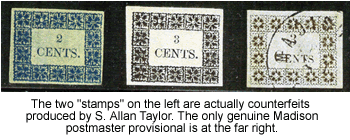 In 1996, I was asked to join the CSA Authentication Committee as Recording Secretary, and subsequently, as a voting member. I had the opportunity to discuss my theories about the Madisons with the chairman of the committee at that time, Peter Powell. Peter wrote a letter to all of the other members of the committee and laid out the reasons why the CSA should consider accepting the Madisons as patients. I t was agreed to accept them for consideration. I submitted the same brief that I had submitted to the Philatelic Foundation along with the patients. Due to the conflict of interest, I was not part of the voting process. This time the Madisons finally got their just due as "3-cent Madison, Florida post secession postmaster provisionals." 34
In 1996, I was asked to join the CSA Authentication Committee as Recording Secretary, and subsequently, as a voting member. I had the opportunity to discuss my theories about the Madisons with the chairman of the committee at that time, Peter Powell. Peter wrote a letter to all of the other members of the committee and laid out the reasons why the CSA should consider accepting the Madisons as patients. I t was agreed to accept them for consideration. I submitted the same brief that I had submitted to the Philatelic Foundation along with the patients. Due to the conflict of interest, I was not part of the voting process. This time the Madisons finally got their just due as "3-cent Madison, Florida post secession postmaster provisionals." 34
What's in a Name?
My original article called the Madisons "U.S. 3-cent 1861 Postmaster Provisionals Used in the Confederacy," a title I rationalized because the money was actually paid to the United States Post Office Department for the service rendered. On the other hand, since as the Foundation pointed out, they weren't authorized by the USPOD, the Confederate Post Office Department had unintentionally authorized them by telling the postmasters to do whatever was necessary. The choice of an appropriate name is endless, from the one I originally gave them to the CSA Authentication Committee's "post secession postmaster provisionals" or "Confederate Provisionals Prepared for the Union Rate." There are many possible monikers, although the 3-cent Nashville provisional does not easily fall into the aforementioned categories for reasons not relevant to this article. I suspect that whatever the Scott Catalogue ultimately calls them will determine how they will be known in the future. My final personal suggestion would simply be "3-cent 1861 Postmasters' Provisionals." (2005 Editorial Note: that is just what they were ultimately called. A completely new section of the Scott Catalogue was created, immediately preceding the Confederate section. It included all of the provisionals cited in the original article, including moving the Tuscumbia, Alabama provisional from the U.S. section to the new 3-cent section.)
Survey of Recorded Examples
There are 5 off-cover used examples of the 3-cent Madison provisional, virtually all quite different, as well as a single known 3-cent used on cover. There is only one known Confederate 5-cent typeset press-printed provisional entire of the same design. Colonel Sam wrote to U.S. Postmaster General Montgomery Blair on March 8, 1861 that he also had prepared a 1-cent stamp, although a copy has never surfaced. In speaking of his stamps, Colonel Sam wrote that "Ordinary foolscap paper was used." The wove paper is pale blue and, during the printing process, gold or bronze dust was blown on the ink before it was dry. This created some of the most attractive provisionals extant. The actual stamp design is 21 mm wide by 17 mm high. Fourteen boxed ornamental stars comprise the frame surrounding the value. The center of each star contains a semicircle. Close examination reveals that the semicircles do not all face in the same direction. This makes these stamps easy to type.
In Conclusion
There are many appropriate adages for this time-consuming project, such as "Quitters never win and winners never quit." Tenacity played a large part in the successful outcome of this undertaking. Most serious postal historians have a little pile of problematic covers for which they don't have all the answers. Simplistically speaking, postal history is research work in progress. New discoveries and fascinating theories crop up all the time, no matter how old the subject. They are the fodder for publications such as this. It is part of the inherent satisfaction of postal history. We're all philatelic detectives at heart. The roller coaster ride of the "chase" is alternately frustrating and exhilarating, but ultimately oh so rewarding.
Somewhere, Colonel Sam is chuckling about all the hoopla over those pretty little golden stamps that he fashioned at the dawning of the War for Southern Independence. A tip of the hat to you, Colonel Sam!
Acknowledgments
George W. Beatty, Marie Bernard, William G. Bogg, Gordon G. Bleuler, John Brown (Inter-Library Loan Office, University of Florida, Gainesville), Frank L. Byrne, William T. Crowe, Morris Everett, Richard B. Graham, Erin R. Gunter, Joseph T. Holleman, Edward R. Joyce, John W. Kaufmann, Steve Kerber (P. K. Younge Library, University of Florida), Charles E. Kilbourne, Billy Matz, Herbert P. McNeal, Jerry S. Palazolo, James H. Perry, Sr., Mary Jo Beck Perry, David G. Phillips, Stanley M. Piller, Elizabeth Pope, Peter W. W. Powell, Roberto Rosende, Warren H. Sanders, Hubert C. Skinner, Frank J. Stanley, Thomas E. Stanton, Herbert P Trenchard, Scott Trepel.
Endnotes